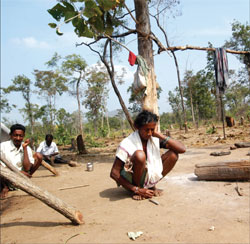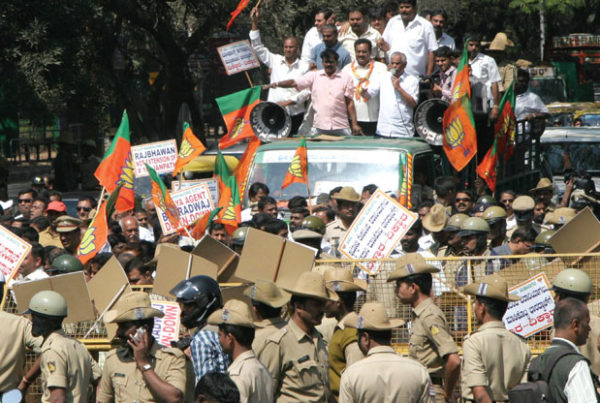 Sanjana Chappalli and Photographer Tarun Sehrawat bike deep into Chhattisgarh’s inaccessible forests, returning with nightmare stories the nation has no inkling about
Sanjana Chappalli and Photographer Tarun Sehrawat bike deep into Chhattisgarh’s inaccessible forests, returning with nightmare stories the nation has no inkling about
A THREE-HOUR motorcycle ride from the border with Andhra Pradesh’s Khammam district and the thick jungles of Chhattisgarh close in. This is remote terrain — villages are spread out over several kilometres; distances measured by the hours taken to walk from one village to another. Schools, hospitals and motorable paths are not even imagined. This is also a self-declared Maoist stronghold. Outside every village stand red concrete columns 25 feet tall, built in memory of martyrs; easy markers even for the uninitiated.

Bereft: The family of a man shot dead by the Judum grieves the loss of their son and their village
Across this remote terrain, over seven days, TEHELKA photographer Tarun Sehrawat and I tracked Adivasis whose lives were destroyed by the Salwa Judum in the past four months. This period coincides with the start of Operation Green Hunt, an operation that the Central Government calls a ‘media creation’.
In village after village, Adivasis recount tales of the Judum attacking anyone they could find — “if they found a woman, they raped her. If it was a man, he was killed.” None of the witnesses that we met were willing to walk to the police station to file complaints. In their eyes, the Judum and the police are complicit. Seeking justice from one against the other would be futile. This was the first time, the Adivasis told us, that the Judum had entered their villages. And their trail of destruction had often covered two or three villages in the span of a day.
We found houses burnt down by the Judum in village after village — and we also found buildings outside another village destroyed by the Maoists. An Adivasi boy pointed out the buildings to us — this was the forest department office, this ananganwadi (creche), here stood the school, here, a police outpost. Three years ago, he said, they were destroyed by the Maoists. Three hundred children studied there till Class 8. The nearest school now, he said, was at least 40 km away. Expectedly, not many children go that far. Elsewhere, felled electricity poles blocked our paths. Ask the leader of the Maoist squad in charge of the area about the destroyed schools and we hear a reply often heard before: “The police were using the school building as a shelter”. She had no defence when asked about the children who used to study there. If the area was under our control, the Maoist leader continues, people would have been running their own schools. Anyone who has travelled within Maoist territory will recognise these empty, practised lines. “When the time comes” — a future that eclipses the present.
VILLAGERS SAY SEEKING JUSTICE AGAINST THE JUDUM FROM THE POLICE WOULD BE FUTILE
We met both armed and unarmed Maoist cadres at every turn. Conversations touched ideological debates as well as ideas of the everyday. One cadre, while serving us lunch, smiled shyly as she called her husband ‘patni’ (the Hindi word for wife) and told us that she had learnt Telugu from him. A minute later, as guffaws echoed across the gathering, she jabbed at the rice in embarrassment and refused to look up. As the mirth died down, we asked why the Maoists were not able to stave off the attacks by the Judum in their stronghold. The squad leader tells us that they were badly outnumbered — an explanation that seemed far too easy considering this was, by their own definition, a stronghold.
From a land where the bleak futility of the war between the Maoists and State actors like the Judum is most sharply crystallised, the following pages chronicle the haunting voices of Adivasis caught in the crossfire.
Related stories:
—
This article was originally published in Tehelka, a leading independent news magazine in India, known for its investigative journalism.


